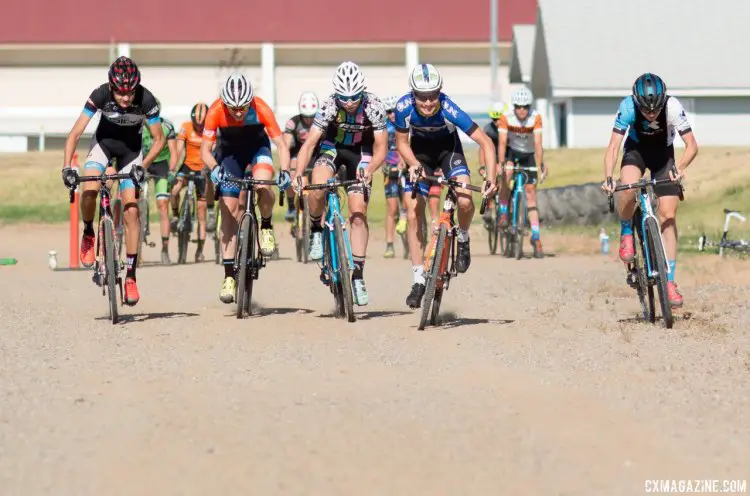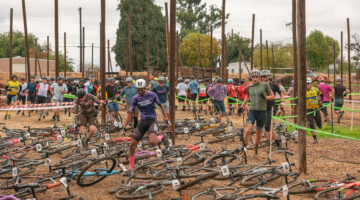A few weeks ago, we highlighted the rigorous off-the-bike routine that Montana Cross Camp attendees faced each morning at sunrise and brought you along for all the learning and none of the sweat.
That morning routine was just one of three daily camp workouts that necessitated three daily showers.
Today, we continue our behind-the-scenes look at Geoff Proctor’s camp by giving you a look at some of the on-the-bike drills Geoff Proctor and his team of coaches (Chris McGovern, Tobin Ortenblad, Scott Herzig) served up on the final day of camp.
Come along for the ride. Leave the bottle cages at home.
Help with Hand-Ups
After a post-morning workout shower and breakfast, the cyclocrossers had little time for digestion. Instead, the campers created dorm hallway congestion while removing the bottle cages used for Thursday’s gravel ride and airing up tires for the short ride across town to Helena High School for some skills work.
Geoff Proctor is as straight-laced as they come, and the goal of the camp is to prepare riders to compete at the highest level, whether that’s in Europe or against the domestic pros.
As most pros know all too well, finances are a critical component in ensuring a racer can eat well, race on good equipment and travel to races, and every dollar matters for most up-and-coming racers in our sport. Thus it’s fitting that Proctor’s first on-the-bike drill on the camp’s Friday makes sure attendees are ready to go out and grab every dollar—even those stuck to a barrier or in a beer can.
Since the campers had removed their bottle cages for the morning workouts, they need a place to put their water bottles. Proctor has them place them on the ground in the parking lot while riding to the track and then turn around and pick them up while still on the bike.
The success rate is about 50 percent, which doesn’t seem to impress Proctor—perhaps it’s because that’s a lot of dollars going to waste.
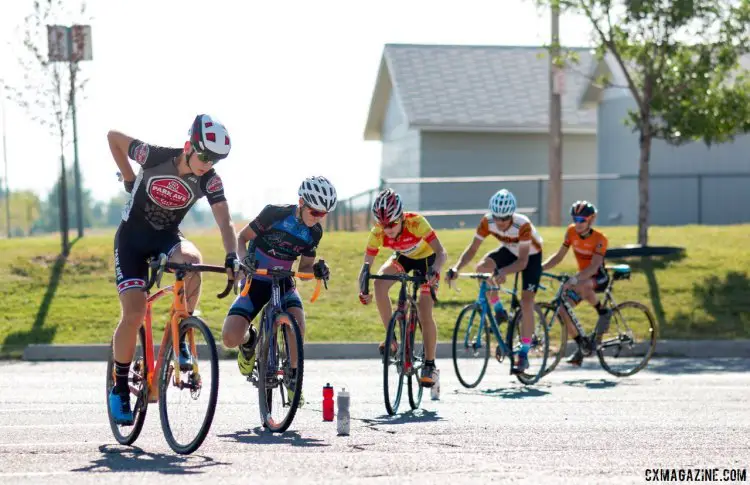
Campers work on their on-the-bike agility, including reaching down to grab their water bottles. 2017 Montana Cross Camp © Cyclocross Magazine
When the group arrives at the dirt track, Proctor has them repeat the drill. Failure results in a dirty nozzle, and an occasional dirty look from a coach. The fun is just beginning, and thankfully there’s no harsh penalty for failure, yet.
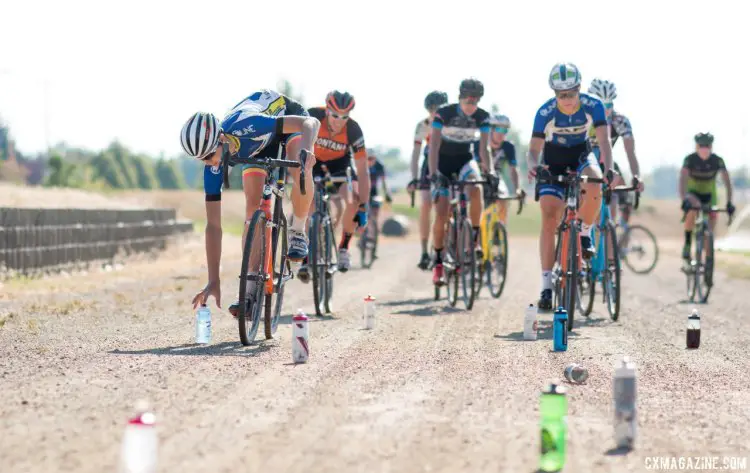
Proctor has racers first start their on-the-bike drills with a water bottle grab, and intentionally or not, has them ready for dollar hand-ups. 2017 Montana Cross Camp © Cyclocross Magazine
Start Your Engines, Again and Again
Geoff Proctor is preparing racers to ultimately be successful at the sport’s highest stage, and when competing against the world’s best on technical, muddy courses, a fast start is important to get ahead of the inevitable congestion.
Fast starts involve far more than a good call-up position, as Lars Boom can attest to and Peter Sagan has proven. Proctor prepares his campers to fight for and defend race positions, lining them up in groups of five for 100-meter sprints down the school’s dirt track.
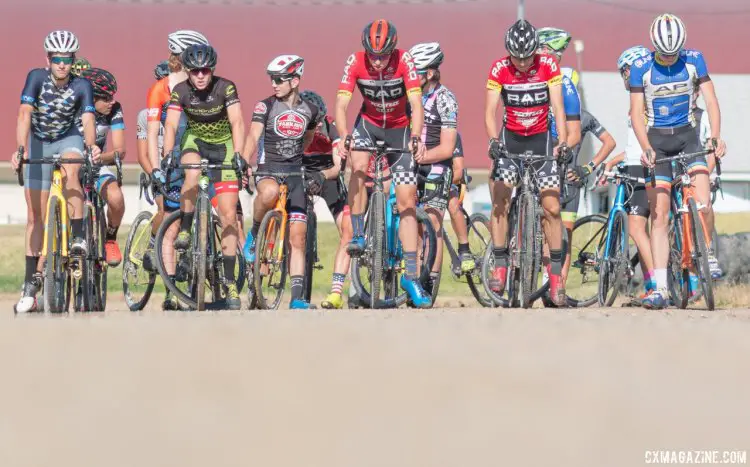
It is every man for himself as friends and teammates alike have to do battle for imaginary holeshots. 2017 Montana Cross Camp © Cyclocross Magazine
The campers stand coiled for the hole shot, ready to be the first to clip in and then enter rapidfire mode on their shifters as they race down their cassette and power to the first turn.
For some, it’s a chance to literally rub elbows and bang bars with their idols.
While for others, it’s a welcomed chance to scope out their competitors and scare them off with roars, albeit in a warmer, more friendly setting than a cold January Nationals:
Campers do several sets of these, some with animated, energetic sound effects, but soon they’re all lying on the ground.
Being Pushy Is Good
After several rounds of these all-out start sprints, the group is on all fours, on the ground. Thankfully, it’s not because they’re ready to purge the all-you-can-eat Carroll College cafeteria breakfast (as I am ready to do after just trying to chase them with a camera), but because Proctor wants them to be ready for everything, including putting a crash quickly behind them.
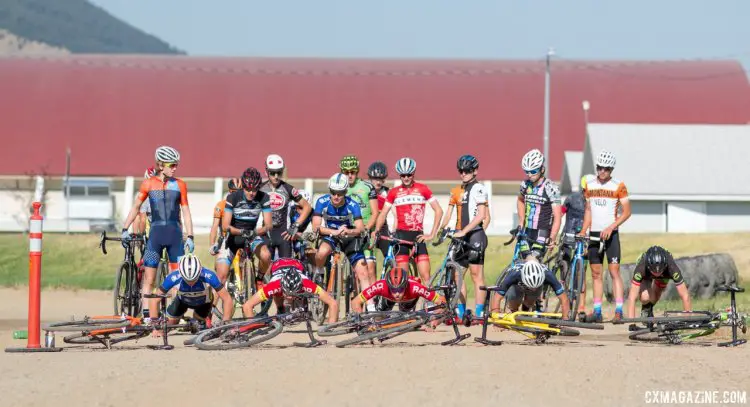
Push-up Start Drills at 2017 Montana Cross Camp with Cam Brooks, Scott Funston, Calder Wood, Ben Gomez Villafane and Alex Morton. © Cyclocross Magazine
Racers practice such a scenario by lining up on all fours and completing a push-up before grabbing their bikes, remounting and then sprinting down the track.
It’s a full body effort that looks more like a CrossFit drill than a bike ride.
“It’s a really good exercise for coming back from a crash, from being involved in a crash [and] getting to your bike,” says Proctor.
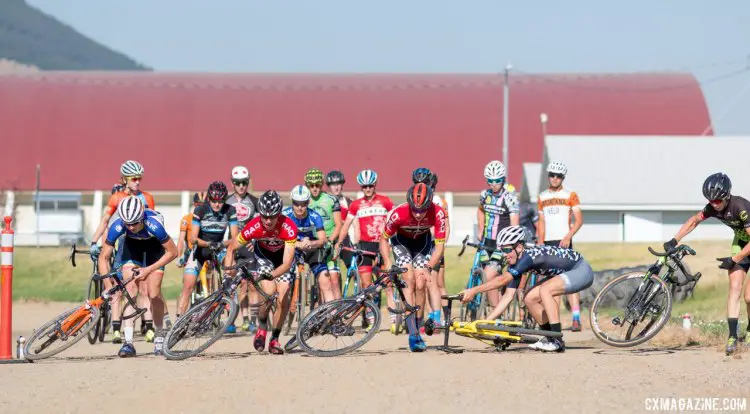
Push-up start drills at 2017 Montana Cross Camp lead to a bike pull-up before a remount and sprint. © Cyclocross Magazine
Watch two different views of this drill in action below:
A One-Question Exchange Policy
“Lower pressure!” shouts Nicholas Petrov, as he rolls towards Proctor and Gage Hecht, who are standing in the imaginary pit.
It’s July, the temperature is in the 90s and there’s no mud to be seen, but campers are out practicing their bike exchanges.
Serious cyclocross requires serious practice and preparation for any scenario, and Proctor preaches that repetition is the only thing that can make knowing what to do second nature. Campers roll in on their own bike, hand it off and hop on a new-to-them machine. Varying seat heights add to the challenge.
Petrov, one of the youngest attendees, completes his dismount, hands his Focus Mares off to Hecht and hops on the foreign bike that Proctor is holding out, which happens to be Luke Feuerhelm’s Jamis Super Nova.
“Lower pressure,” repeats Proctor. “How much?”
“Ten psi!” Petrov responds as he rides away.
The pit crew chuckles at the giant fictional adjustment.
Most of us amateur racers will never be so fortunate to have or need a two-man pit crew and a clean bike waiting for us in the pits. We’re lucky if we have spare wheels or bike to lean against a pole or a teammate racing a later race who kindly holds out their bike for premature dirtying when we have a mishap.
These kids are not your average amateur racers. Most of the Montana Cross Camp attendees revealed to Cyclocross Magazine dreams of becoming a cyclocross pro. With such ambitions, they’re training to not only know how to swap bikes at speed but also to communicate effectively with a pit crew while under duress.
“Flat,” Andrew Frank says calmly as he goes in for an exchange.
The campers and pit crew start to get into a rhythm and a steady rotation of exchanges is underway. There’s no power sprayers, tools, pumps or spare wheels in this pit. Hecht grabs a bike from a rider, Proctor hands another one off, and Hecht passes the one in his hands to Proctor to recirculate.
“I crashed!” says another camper as he hands his bike off.
“My motor is broken!” jokes another as he approaches, which generates some laughter.
The loop continues through a handful of riders.
Nathan Knowles comes in for an exchange and executes a smooth hand-off, grab and remount. His hands go straight to the bars, he takes two steps and is quickly on his new bike.
At any other practice, Knowles would receive a few cheers and the coaches’ praise for his exchange.
Proctor’s praise? “Ten push-ups Nathan!”
Knowles dismounts and drops to the ground, paying the only penalty in the country enforced by a high school teacher for being quiet and not lying.
Knowles isn’t alone. Soon John Paul Amalong is down on the ground building upper body muscle as well, all because he didn’t answer one essential question when approaching the pit crew for his exchange:
What’s wrong with the bike?
Shouldering Responsibilities
Montana Cross Camp hopes to help create leaders, and part of that leadership requirement is being able to calmly shoulder the load in odd or unexpected situations—last year’s epic Friday night mudder at Jingle Cross that many of the Midwest Juniors competed in comes to mind.
In these situations, Proctor wants the campers ready to reach up and grab a clean bike from the pit crew and take off running.
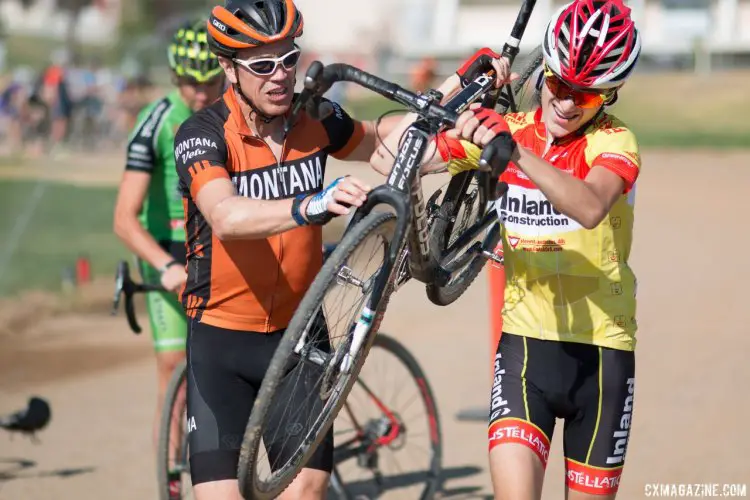
Geoff Proctor has campers ready for anything, including the rare-but-useful shoulder bike exchange. John Paul Amalong takes the hand-up and prepares to take off running. 2017 Montana Cross Camp © Cyclocross Magazine
Proctor admits needing to run with a fresh bike is a relatively rare situation, but he would rather have his students doing homework during the summer than arrive at their final exam in Reno or Valkenburg unprepared.
Embracing Racing
All the work at training camp is, in the end, designed to help attendees improve their cyclocross racing. On Friday, there’s some real cyclocross racing that forces campers to put all the skills and drills together.
Coach Chris McGovern assembles the racers into three-person teams for a relay race that covers a tight, technical course complete with two barriers and lots of off-camber ups and downs.
Suddenly, the fight for the holeshot becomes a lot more complicated than sprinting down a dirt track:
After the relay race, the morning’s final competition is an all-out effort on an extended course that takes all of one minute for a lap. Coach Tobin Ortenblad attempts to do call-ups in a handicap style, sending U23 stars Gage Hecht and National Champion Lance Haidet to the back, while giving the younger racers first-row status.
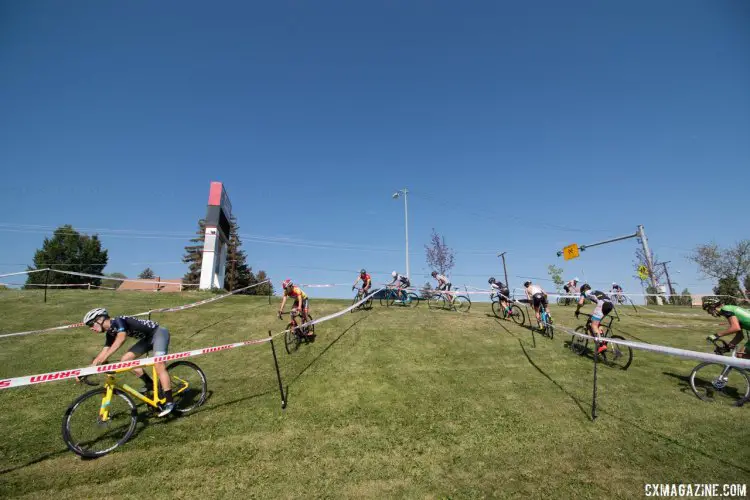
The campers compete in one final race on Friday of the camp. 2017 Montana Cross Camp © Cyclocross Magazine
Greg Gunsalus does his best Lars Boom impression to barge through the field and hit the barriers first. With two smooth bunnyhops, he’s off and not running.
Behind him, racers play musical chairs, but with only a handful of one-minute laps in the queue, the song runs out before anyone catches up to the bunnyhopping leader.
Sand Command
On Friday, the last of four straight days of on and off-bike workouts, after two hard morning workouts, the campers’ competitive desire seems to be waning a bit. The group slowly rolls back to Carroll College from Helena High, but soon most of their bikes and drivetrains will be grinding to a halt.
The beach volleyball courts await.
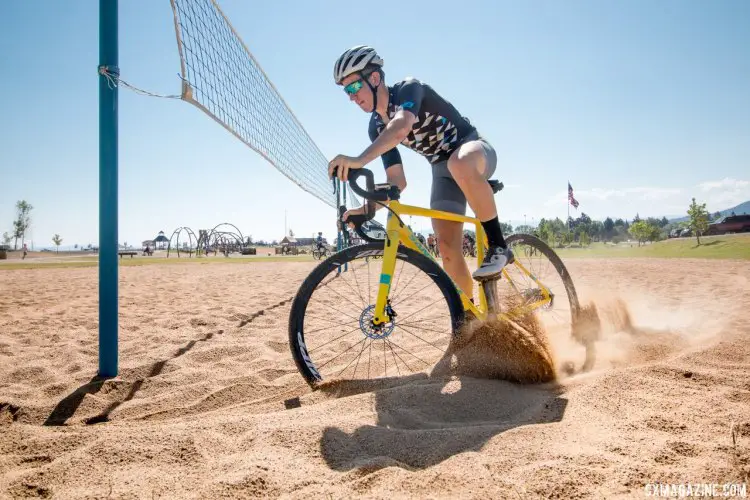
2016 National Champion Ben Gomez Villafane eyes the sand hairpin. 2017 Montana Cross Camp © Cyclocross Magazine
One by one, the racers plow into the sand in hopes of maintaining enough speed and control to execute a hairpin turn around a far pole without dabbing or dismounting.
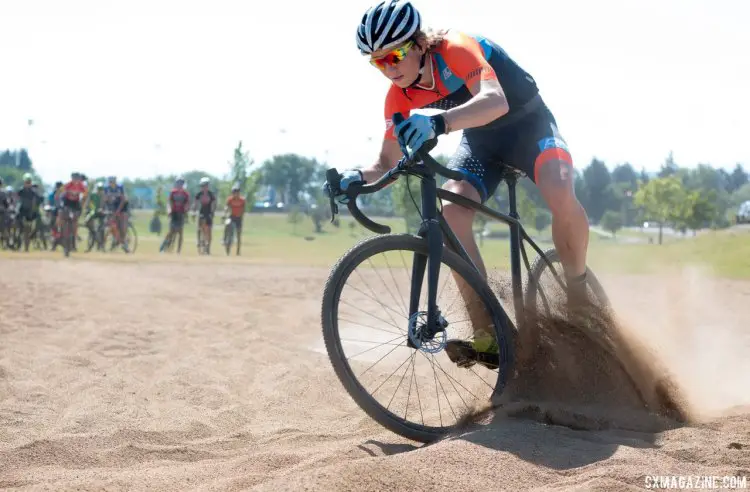
Kelton Williams digs in on his way to the sand hairpin turn. 2017 Montana Cross Camp © Cyclocross Magazine
The success rate is less than half, but most campers master it at least once. Ben Gomez Villafane demonstrates.
Coaches gather at the turn, and racers who have had enough form a growing crowd. If it was a local race, it would be heckler and hand-up headquarters, but at Montana Cross Camp, only advice and encouragement are heard from the gaggle of spectators.
Trial runs aren’t so spaced out that real world race scenarios don’t present themselves. Gage Hecht has to react quickly when Alex Morton takes a trip to the beach:
Carry That Sandy Drivetrain
Who wants to pedal a sand-covered chain back up a hill back to the dorms?
Geoff Proctor avoids such a grind, and he makes sure the campers do as well.
With the dorms in view, campers have to line up one final time for one last push—an on-foot race up the hill— with bike in tow.
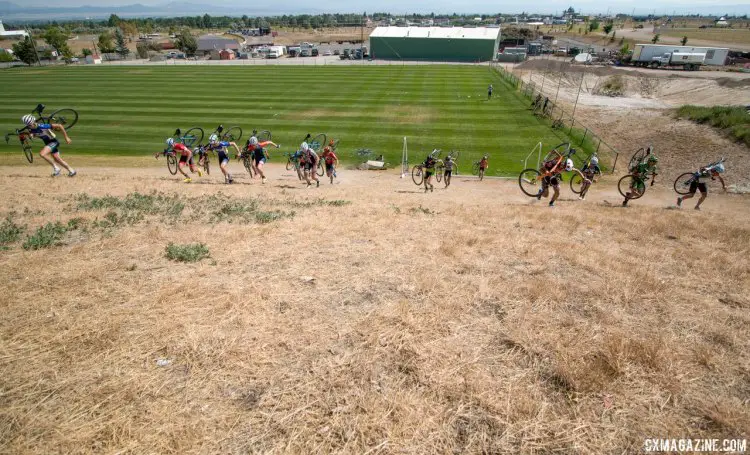
Campers run this hill with their bikes before wrapping up the skills work and heading to lunch. 2017 Montana Cross Camp © Cyclocross Magazine
For most campers, it’s a welcome final ascent up this dry, grassy hill that they’ve seen all too much of during the week.
Because it’s the final day of camp, the typical long, hilly gravel ride in the afternoon is replaced with yoga and ice cream.
For most, the hardest part of camp is over.
For one talented rider, it has yet to come.
Stay tuned for more continuing coverage of Montana Cross Camp. See Part One of our look inside Montana Cross Camp here and watch our ever-growing collection of interviews of the athletes here. Our growing gallery of photos from camp is viewable here.













